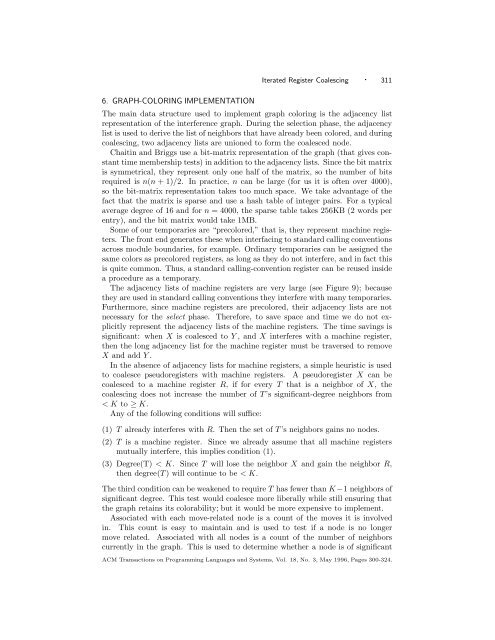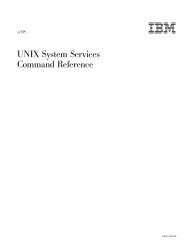Iterated Register Coalescing - School of Computer Science
Iterated Register Coalescing - School of Computer Science
Iterated Register Coalescing - School of Computer Science
You also want an ePaper? Increase the reach of your titles
YUMPU automatically turns print PDFs into web optimized ePapers that Google loves.
<strong>Iterated</strong> <strong>Register</strong> <strong>Coalescing</strong> · 3116. GRAPH-COLORING IMPLEMENTATIONThe main data structure used to implement graph coloring is the adjacency listrepresentation <strong>of</strong> the interference graph. During the selection phase, the adjacencylist is used to derive the list <strong>of</strong> neighbors that have already been colored, and duringcoalescing, two adjacency lists are unioned to form the coalesced node.Chaitin and Briggs use a bit-matrix representation <strong>of</strong> the graph (that gives constanttime membership tests) in addition to the adjacency lists. Since the bit matrixis symmetrical, they represent only one half <strong>of</strong> the matrix, so the number <strong>of</strong> bitsrequired is n(n +1)/2. In practice, n can be large (for us it is <strong>of</strong>ten over 4000),so the bit-matrix representation takes too much space. We take advantage <strong>of</strong> thefact that the matrix is sparse and use a hash table <strong>of</strong> integer pairs. For a typicalaverage degree <strong>of</strong> 16 and for n = 4000, the sparse table takes 256KB (2 words perentry), and the bit matrix would take 1MB.Some <strong>of</strong> our temporaries are “precolored,” that is, they represent machine registers.The front end generates these when interfacing to standard calling conventionsacross module boundaries, for example. Ordinary temporaries can be assigned thesame colors as precolored registers, as long as they do not interfere, and in fact thisis quite common. Thus, a standard calling-convention register can be reused insidea procedure as a temporary.The adjacency lists <strong>of</strong> machine registers are very large (see Figure 9); becausethey are used in standard calling conventions they interfere with many temporaries.Furthermore, since machine registers are precolored, their adjacency lists are notnecessary for the select phase. Therefore, to save space and time we do not explicitlyrepresent the adjacency lists <strong>of</strong> the machine registers. The time savings issignificant: when X is coalesced to Y ,andX interferes with a machine register,then the long adjacency list for the machine register must be traversed to removeX and add Y .In the absence <strong>of</strong> adjacency lists for machine registers, a simple heuristic is usedto coalesce pseudoregisters with machine registers. A pseudoregister X can becoalesced to a machine register R, if for every T that is a neighbor <strong>of</strong> X, thecoalescing does not increase the number <strong>of</strong> T ’s significant-degree neighbors from









